This is the game we have created out of our understanding and interpretation of the work The Picture of Dorian Gray by Oscar Wilde. Primarily, Mariella did the editing, programming and the first three steps to the story, which includes the wrong turns. Emi, did the middle steps which included steps three to five, which also includes the wrong turns. I did the last steps from steps five to eleven or so (conclusion of the story), and the wrong turns to the story as well. This was a very great experience for me as I have always aspired to become a writer, and this is a good opportunity to try and write story like material. Some limitations to this project was our time limit. Because of the time constraint and our other obligations (e.g. job, or other classes), we were not able to make the story as extensive as we hoped to. We were unable to add more side stories, wrong turns and complexity to the existing work we have on hand. However, with the given time and constraints, we were able to create something pretty amazing, and I hope you come to enjoy it!
Author: Carina Yuen
Text Comparison of a Passage from The Picture of Dorian Gray, Censored and Uncensored Versions

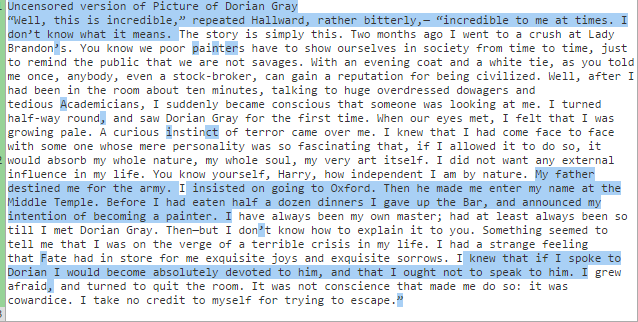
These two versions of The Picture of Dorian Gray were accessed from the SFU library and compared on a free text comparing site. Despite this site not providing a percentage of similarity, by reading this particular passage, a few key differences can be distinguished (the highlighted blue is the difference). The major difference between the two texts is that the uncensored version was more deliberate and explicit (e.g. “I grew cowardice” or “I knew that if I spoke to Dorian I would become absolutely devoted to him, and that I ought not to speak to him.”), and more sure of what was being said. There was also more detail provided in the uncensored version that is not found in the censored version. These details create a rounder character for those involved which in this particular passage, are Basil and Henry.
The reason for censoring and cutting out passages is partially due to the leeway it could provide for Wilde to escape criticism for promoting romance between two males. This is definitely so when the phrase “a sort of” is added to the sentence “it was cowardice”. This ambiguity to what type of cowardice Basil is talking about allows Wilde to cloak whatever intentions Basil or he has, allowing him to argue that his form of cowardice is just his lack of confidence to talk to a very handsome young man, instead of his cowardice to pursue a possible love. The middle passage that has been taken out from the uncensored version does two things: create a round character out of Basil with the inclusion of his origins, and a reason for the sentence “I have always been my own master”. By removing this section, Basil becomes more of a flat character, and the sentence that follows (“I have always been my own master”) seems to have been an idea taken out of thin air, or an idea that both characters in the scene have already established. There is nothing wrong with removing these details, however, it removes the audience’s engagement with the text slightly. The top section that was removed from the uncensored version in the censored version does the same work as the removed middle section, which is to characterize and make Basil a much more engaging character. The removal of these bits and pieces of description on emotional shifts, removes the character’s personality, and if done continuously, makes the character very flat and possibly unpredictable.
By comparing a small but important section of the two versions of The Picture of Dorian Gray, Wilde’s elimination of a lot of details and inclusion of more ambiguous words, help give Wilde a larger leeway in escaping criticism. However, in doing so, the characters involved become less relatable and become more of a flat character instead of a dynamic and round character. Because of the lack of development in some characters, it also becomes problematic when they take up actions that are seemingly unpredictable because the earlier actions or descriptions of them are now taken out. This leads me to believe that despite the original uncensored version being littered with many ‘taboo’ subjects, it would be a much better read for the audience if they are capable of pushing aside their radical emotions against the topics spoken of in this work.
News Paper Report on The Wilde Trials
Lloyd’s news paper on Oscar Wilde Trial June 2, 1895, issue 2741
In Lloyd’s Weekly Newspaper issue 2741 published on June 2, 1895, the newspaper gave a fairly explicit and detailed report of Wilde’s last trial that happened a little over a week from the day of publication. The main reason I chose to do a reading and report on this particular newspaper is that it gave nearly half the page to Wilde’s third trial and is not as sensationalized as other newspaper reports that I have read. Some things that I realized while analyzing this particular report is that it plays in favor of Wilde by using words with positive connotations to portray Wilde as someone worth pitying. An example would be “[h]is mouth moved, but all that could be heard was a hollow cry, ‘Can’t I say anything?'”, (Bottom second column), and “[t]he witness was questioned in detail relative to the literature and the correspondence connected with the case, and he gave his explanation of the various phrases appearing in the correspondence, which was practically a repetition of what he said during cross examination at the last trial”(Mid-Bottom, first column). These two particular quotes from the newspaper puts in a bit of the author’s opinion which seems to lean towards favoring Wilde in this trial. Portraying him as someone that was not given a fair trial, and his redundant questioning was used to make Wilde look pitiful and powerless. Therefore, the whole of the newspaper plays as a mostly neutral report, however, there are definitely instances where the author wrote in favour of Wilde, with their use of diction such as ‘practically’ or ‘hollow cry’.
The second thing that I noticed was a tendency that was found across all newspapers, which is the lack of precision in language for what Wilde did. There are two approaches that is taken in the papers to get past this issue, which is either avoiding the word of the crime completely and assuming the reader knows, or using a different word such as ‘indecency’. The paper also assumes that the reader would know what has been going on, and writes as if building upon the last issue. This causes some confusion in the reader especially if you are not a constant reader of this particular newspaper.
The third thing that I noticed was the style and formatting of the newspaper, which leans more towards the newer styles. This newer style leans towards sectioning and giving subtitles to each story. Pictures/portraits are also included which makes the read more interesting. There is also an entire column of advertisement for mostly Lipton. Based on the advertisements, this newspaper would probably be aiming towards the middle class as there are advertisements for also high grade cycles, and wholesale tailors. The weekly publishing also gives this particular newspaper an advantage of gathering more information and being wiser with their choice of words as they are given a longer time period to think over what they have written.
Critical Review: The Picture of Dorian Gray-1973
The movie starts out just as the original work did in Basil’s studio, however, the movie goes on to stray further and further away from the original work from that point onward. The movie adaptation of the work lacked the depth and sinister wonder that was scattered throughout the text, and was brutally removed from the movie. Some of the major disappointments that occurred that I will be discussing is the alteration of the plot by both extending and shortening the story, and the lack of character development in the movie characters (whether it be due to bad acting, or the fragmented plot).
The adaptation strayed away from the original story quite a bit, to the point where the only resemblance between the work and the movie was the title, the characters names, and the major events (e.g. Initial meetings in the drawing room, Dorian meeting Sybil, Dorian killing Sybil, Dorian killing Basil, Dorian stabbing his painting and dying). The introduction of a new character, Basil’s niece Beatrix, introduced confusion in audiences that have already read the original work. The new character continually alters the original story, and also adds onto the ending of the story, which both extends and shortens the original work in this film adaptation. When I say shortening of the plot, I mean that there is little development of the sophisticated plot (mentally or physically) found in the original work, and is over simplified through voice overs to reveal Dorian’s inner thoughts. This simplification and shortening of the original work creates a loss of dynamic, and instead replaces it with a more action packed plot that shifts from one event to another rather quickly. Sybil was also introduced as a bar waitress (which is now merged as both a bar and the opium house compared to the original work), and aspires to be an actress. Dorian’s reason for essentially ‘breaking up with her’ was because he got her to sleep with him, and he lost interest in her. This makes Dorian a much less complex character compared to the original work’s Dorian, and makes him a rather simplistic shallow fellow. The name ‘Prince Charming’ was also not used in the film, and Dorian just goes by the name ‘Dorian’. So when it is found out that Sybil’s brother has come to murder him, there is no complication in finding him and is simply brushed off as “there aren’t many fellows with that name”. Sybil’s brother is also portrayed as, for a lack of a better word, a lowlife/trash of London as he blackmails Dorian for money instead of killing him. This makes his character seem less loyal to his goal of killing Dorian for his sister in revenge, but more so for greedy desires as a lowlife. Despite all of these negative remarks of the film, the director/screen writer did try to put in some key lines to try and make the film seem more sophisticated, but that failed horribly as it was never developed upon.
The extension of the plot starts the moment he realizes Basil’s niece Beatrix has returned from Canada and is to inherit Basil’s money and estate. They fall in love (despite their over twenty years age gap), and they get engaged, then married. Their plan was to leave London and sell off Basil’s estate, which led Dorian to reason that it was a good idea to look at his painting for the last time to see how he has improved in the face of loving and marrying Beatrix. To his surprise, it has become even more revolting and he ends up stabbing it, and dying. The extension of the plot is overdone and dilutes the whole original story into a poor attempt at creating art. The most memorable moment that lead me to realize the extensive contradictions in this film was when Basil saw his painting and calls Dorian a monster and not human, and after Dorian kills him (not with a knife, but with a candle stick holder with two wacks), Dorian proclaims that he has killed the one man that has ever cared for him. These contradictions and poor acting (lack of emotion and change in expression despite the heavy topics in the original story) is just horrendous and a great insult to Oscar Wilde.
With all that being said, the 1973 film version of The Picture of Dorian Gray, is horrendous as an adaptation of the original work for both the fact that it altered the original story too much, and having not very emotionally vocal actors (whether it be the actors or the screen writers fault, I have no idea), caused this film to be a great failure. I would not recommend this film to anyone (especially considering that it was an hour and fifty minute movie). There are probably other adaptations that are much better, and more worthwhile, but this particular film was a complete waste of time, and I regret deeply for choosing this adaptation instead of another.
The Difference in Definition: Gross Indecency
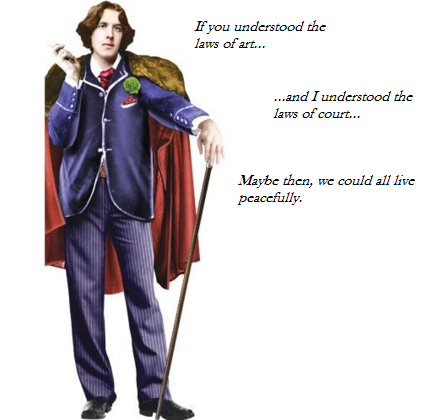
This is yet another digital postcard and commentary on our reading of Gross Indecency: The Three Trials of Oscar Wilde by Moises Kaufman. Our major issue today with the reading of this play is the idea of how similar it is to the traditional three act structure first constructed by Aristotle, and later on adapted as one of the most beautiful and standard structures throughout history. The essence of a three act structure is that the protagonist/hero has a fatal flaw (e.g. pride) and is faced with a single problem and must resolve it, or die (usually). Some common rules that accompany the three act structure is the three unities (time, place, action) which also arises from Aristotle. This particular structure is incredibly beautiful and well rounded, but it also simplifies the plot and problems significantly compared to plays that do not follow this rule. A few examples that come to mind would be comparing Shakespeare’s Hamlet (5 acts), to Oedipus Rex (Single ‘act’ but split into the three unities). The biggest problem with the three act structure and the three unities was that it was too limiting and often, play writes are forced to put these limitations before their story. This often created either public shaming or rejection if they did not follow these rules. This is one of the reasons why Shakespeare was often not revered as a ‘tradition’ and widely accepted play write for the fact that he did not follow the three act structure (strictly speaking) and the three unities (strictly speaking) in his time.
The three act structure and the three unities in Gross Indecency by Moises Kaufman follows pretty closely to the original rules. It is done in three acts, there is a rising action in act 1, then the problem in act 2, and the conclusion and falling action in act 3. The three unities are also mostly met, with a predominant single location (of a court room), and has no sub plot. Time however jumps from the time and date of each procession of the trial and cannot be followed in the traditional sense. Despite that, this play does follow through with the traditional three act structure and three unities very closely. The problems with this is precisely how clear cut each character is portrayed as either the protagonist/hero (Oscar Wilde), or antagonist (court, or Douglas). A fatal flaw (pride), a clear plot that has a problem, rising action, falling action and conclusion also over simplifies the story. This over simplifies the real story of Oscar Wilde’s trials and puts the blame entirely on Douglas as being the cause of Oscar Wilde’s downfall. Though the play sometimes brings up the ambiguity of Oscar Wilde being truly ‘guilty’ or ‘not guilty’ (Kaufman 84), and if he truly was a homosexual and conducted his acts of sodomy, to fulfill the three act structure, those ambiguities did not matter. The particular ending of Oscar Wilde revealing himself to Harris (114), does not do Wilde justice in making him a human, but casts him as a character. This is the first problem that seems to arise from both this trial and this play, that we caste Wilde as a homosexual (a new type created as Wilde was charged) for these acts of ‘gross indecency’ without ever really taking into consideration his side of the story seriously. Because they take that Wilde ‘looks’ to be a man that would conduct these acts, he is therefore someone that does conduct these acts. Secondly, the clear act of antagonizing Douglas was set up to be the man that caused Wilde so much trouble (e.g. “My family will be only too delighted to pay for all costs and expenses to try my father…of course his family never paid for the costs of the trial” (24), “Once Douglas left I was suddenly struck by a sort of likeness, a similarity of expression and of temper between Lord Alfred Douglas and his unhappy father”(30), “After Wilde’s death Lord Alfred Douglas married and had two children. He became a Catholic, and eventually a Nazi sympathizer”(130)). This act of antagonizing Douglas follows the clear cut rules of the three act structure and the three unities, however, because of this, it over simplifies the real story of the trials and Wilde’s life, making everyone involved simply a character and nothing more.
There are benefits to this way of presentation despite the many problems that arise because of it, and that is the accessibility and the easy presentation it provides for readers. This allows people that have no idea who Oscar Wilde is, a quick synopsis and presentation of what he stood for, and what happened to him. This was easy to read, easy to understand, and shifted the audiences’ sympathy towards Wilde despite what he was accused of. This over simplification of the people into characters also has its benefits as it pointed a light towards a reality that the English government did not want to reveal.
My post card with the quote “If you understood the laws of art… and I understood the laws of court… Maybe then, we could live peacefully” is a summary of my interpretation of the outcome and shortcomings of both Wilde and the Government (as represented by the lawyers of the Crown). If Wilde never entered the first accusation of Queensberry, he would have never entered this mess and set foot in a prison. If the Government did not enter into these trials to accuse Wilde of gross indecency, they wouldn’t have become a laugh stock for condemning a famous poet to save the politicians. If the two groups knew of each other’s rules, then there would not have been any conflict, and no one would have gotten hurt. However, it is not to say that Wilde’s trials and imprisonment did not contribute to the greater good of society and art. Without Wilde’s trial and charge, the term and idea of homosexuality would never have been born. This new identity would have never been conceived, rejected, and then accepted. Wilde’s act of going into court may both be incredibly stupid and/or courageous, but that is not for us to decide as we were not there living the life of Oscar Wilde. I believe that whether Oscar Wilde walked into these trials out of pure emotion, or out of creating a new art form, or pushing the limits of ‘living art’, he changed the way we view life, sexuality, morality, and art. Without this last stroke of art in his life, he wouldn’t have died and concluded his story with the beauty he wanted to find in both art and life.
Word Mining and Wilde’s Style
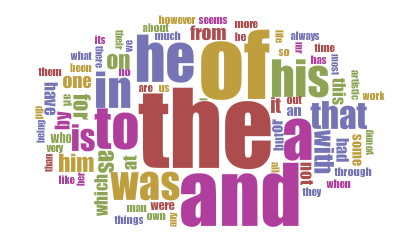 Pen, Pencil, and Poison
Pen, Pencil, and Poison
(art-30, life-17, artistic 13, true-10, modern 9, style 9)
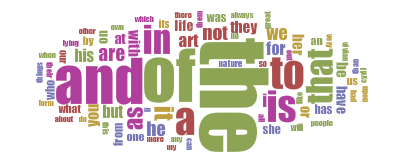 The Decay of Lying
The Decay of Lying
(nature-48, lying-31, artistic-15, fact-15, beautiful-10)
In this post, I have done a bit of word mining in the two works “Pen, Pencil, and Poison” and also “the Decay of Lying” by Oscar Wilde. The purpose of this exercise was to use a new technological method in order to have some insight into the style of Wilde’s writing. As you can see from just the pictures (word clouds) above, there are a lot of conjunctions and verbs which should come to no surprise, as most compositions are like so. However, the selected reoccurring words that I have chosen above in the parenthesizes are both similar in topic and occurrence in their respective works. Oscar Wilde has been discussed throughout the class as someone that lives a life of art; either it be by performing and lecturing his perspective of what art should be, or writing different modes of literature. A few stylistic methods of writing that I have noticed is his insistence towards his lifelong thesis of “art for art’s sake”. He insists on a mode of living and thinking that glorifies art as societies savior to the ugly systematic lifestyles that most of us live by, which maybe in itself a piece of art by his definition. His stance in “The Decay of Lying” is portrayed through Vivian, who is convincing Cyril the decay of lying, creativity, and art. He juxtaposes the idea of creativity/spontaneity against habit/routine, and that we are falling closer to one that is governed by conventional means instead of one that is full of spontaneity and life. “Pen, Pencil, and Paper” is a memoir of Thomas Griffiths Wainewright and his life in a non-conventional lens. It is written with a heavy note on art and his enviable lifestyle as someone that expressed his art through writing. His killings were either briefly mentioned or brushed off as another chore that he had once done in life. It is somewhat misleading if not unfaithful to the audience for glorifying a man that has murdered simply because he had held great value for art in his heart. This tells us several things about his persona as a writer through either text mining or through the tone of his writing, and that is his stubbornness for his thesis in life (which is art for art’s sake), and also his naive thinking of society and life. Claiming that he is naive is somewhat of a bold move I will admit, but I will do so on the basis of my opinion and views of the world currently through my readings and schooling. His writing is unconventional, which I have mentioned before, as its sole purpose imitates his life thesis “art of art’s sake”. He writes with the need for money due to his high standard of living and desire to be acclaimed as one of the great thinkers/writers of his time. This is one of his fatal flaws that made him less than the greats in my opinion. His goal was to be great, his goal was not to discover or truly think, which most of the great thinkers and writers did. He is stubborn with his rose coloured lens when he writes ‘for art’s sake’, and his theories or ideas that he writes of in his stories are mostly imitations if not outright plagiarism of other people’s work. His stance in his writings/ lectures are always quite strong and sure, (e.g. usage of words like true, fact, artistic, life, etc.), but his ideas are never in unison. They are like different shades of one single colour, and he puts all the same colours together, but his works come out to be a montage of different shades of a single colour. He is disingenuous with his means of reaching his ends, whether he is aware of it or not, but I think that this method of expression does not deserve to be crowned one that is of the great thinkers or writers.
The House Beautiful, Podcast
The original idea behind conducting this short three minute podcast was to experiment on the whole idea of carrying out a podcast that we often hear over the radio or online. It proved difficult to find a location on campus to record without feedback (as you will hear with the air/whine sound in the background) and the amount of effort and time it took to record and to edit. We did a short analysis of the intent behind “The House Beautiful” by Oscar Wilde to further understand his intentions and how successful he was carrying that out. The whole process was a great experience and one of the first I have had in this field. Further experimentation on this medium of presentation may be taken on further into the course or even in life, but as of now, our final product is in its best state (with our limited technology and experience). We hope that you enjoy our short podcast!
Sin is but a Game
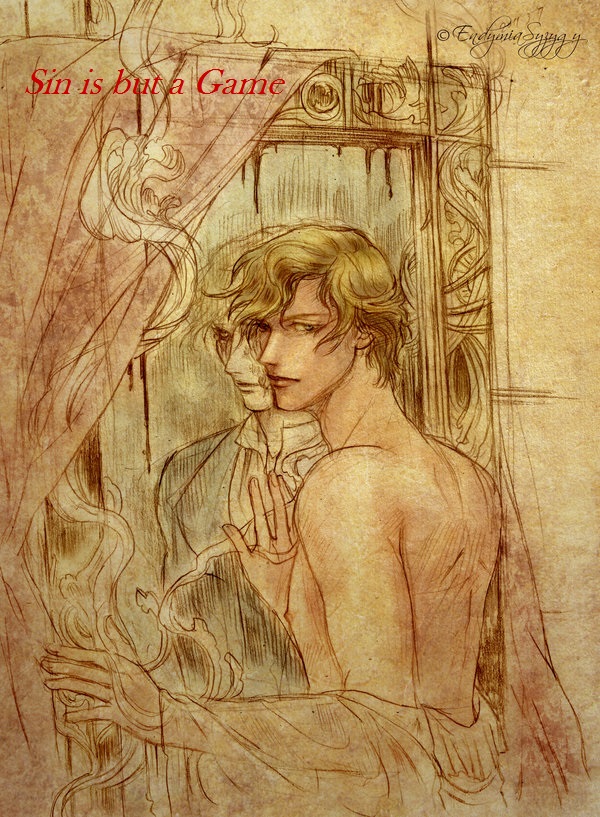
As I finish The Picture of Dorian Gray by Oscar Wilde, several questions plague me, and don’t seem to want to settle. Do I like the book? Do I agree with what Lord Henry preaches? Is Oscar Wilde a genius or something of a great imitator? With these questions in mind, I absorb The Picture of Dorian Gray and anticipate the next great sin that Dorian can possibly commit, but is somewhat disappointed with its rising action and climax. The book is partly a commentary and story of the bourgeois/aristocrat lifestyle of the 1800, and the undying desire to push forth for experimentation in every direction that religion has once bound. Sin is the synonym for experimentation and pleasure that Dorian takes up with his untarnished appearance, masking the sins that he commits to satisfy his soul with the means of the senses. ‘To cure the soul by means of the senses, and the senses by means of the soul’ is what leads him to his doom. The plot and all the monstrous things that Lord Henry speaks of is quite intriguing and quite different; taking the more pessimistic outlook on life. His comment on the only people worth talking to are ‘women with a past and men with a future’ is quite interesting as he possess a stance on a set of traits for the ‘ideal’ woman that is somewhat different from what is traditionally thought of as ideal (i.e. virtuous, innocent, god loving, etc.). The Picture of Dorian Gray is littered with several comments such as the one above that piqued my interest quite a bit, but I was unable to come to terms with my stance on his opinion. As Dorian has said to Lord Henry upon the sinister book given to Dorian, it simply fascinated me, but I did not quite like it. Its prose is quite similar to some of the modern works that use ‘flow of consciousness’ as a mode to communicate the internal self. Though it reminds me of this mode sometimes, it does not completely take on this form. The moment in which Basil asks Dorian to pray for forgiveness also reminds me of the play Doctor Faustus by Christopher Marlowe published in 1592. The character between Faustus and Dorian are actually quite similar in a few characteristics; their limitless ‘power’ used for simple pleasures, their quick and sudden changes in personality when coming close to repentance, and the overarching theme of a contract with the devil. Though Dorian does not communicate with the devil outright, his stilled image and the decaying painting is said several times to be ‘demonic’ or ‘unnatural’. His sudden desire to murder Basil as he is praying for his soul to be saved also resembles the devil’s influence on Faustus when he comes close to repentance. These similarities that I see throughout Wilde’s work and other authors’ work published before him, pushes me to question whether or not I find Wilde to be a genius or a great imitator. With my limited knowledge to the world of European literature, I am still able to find similarities between older works and Wilde’s work. I have also noticed that in The Picture of Dorian Gray, there is a greater consistency with mode/school of thought compared to his other essays in my opinion (e.g. The Decay of Lying). Finally, the quote I have written in the above picture, ‘Sin is but a Game’, was the first thing I thought of when I was given a task to place an epistolary text as a audiological commentary on The Picture of Dorian Gray. The reason simply being it is what I believe to be the best way to describe Dorian’s life the moment he has an epiphany of his true nature. Sin is taken in the traditional manner of breaking the rules of indulgence, but as Lord Henry has once commented on literature, ‘The books that the world calls immoral are books that show the world its own shame.’ I believe that is the same case here with sin and indulgence. There is no such thing as sin (to a certain degree), but it simply shows the world its own shame. The scientific advancements, the jumps in technology, medicine, knowledge, development, etc., are done partly because we break social rules and commit ‘sins’. Without our curiosity weighing above our religious morals, would we be here today with what we have? As Dorian commented on his experience with the poisonous book ‘…he looked on evil simply as a mode through which he could realize his conception of the beautiful’. As should we, in our thoughts of what sin, shame, social rules/laws should be.
.
The House Beautiful
This is a Wilde inspired design with detail recommendations in a house that Wilde has made through his work “The House Beautiful”. I have created two rooms with the focus on the living room to imitate the directions that Wilde has given in his work. I have used a dark but simple wall paper and symmetrical and moderate sized windows. The furniture is quite simple and are chosen for colour coordination of white and blue. There is a dark wooden flooring that Wilde prefers inorder to draw out the simple furniture that I have chosen. In his work “The House Beautiful”, the concept of ‘flow’, ‘yin and yang’ or ‘feng shui’ struck me as a similarity between his work and Asian thoughts. It is obvious through the tone of Wilde’s “The House Beautiful” to pick up hints of bias towards the more luxurious life styles and materials, but he makes several points on how to stylize your home and even lifestyle so that anyone can appreciate the beauty in a well decorated home. He suggests that it is not the material per say that always makes something beautiful, but the way you decorate and organize these materials that make something beautiful.

